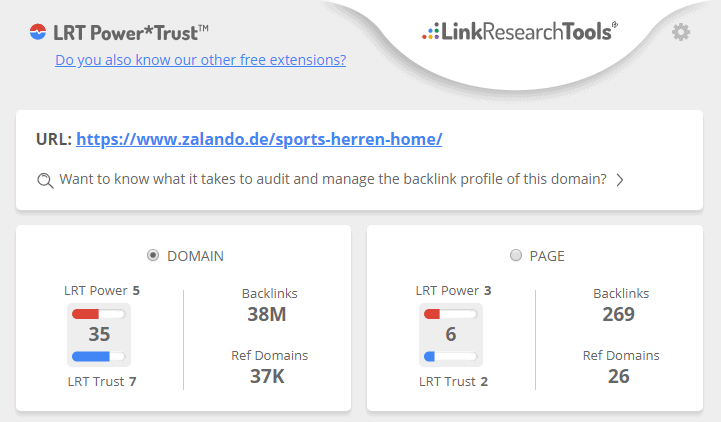
You need backlinks for SEO! You hear that repeatedly. But how do you actually know whether a certain link is really of high quality? Is that even measurable? And if so, which of the various metrics is the most significant for the quality of a backlink? We want to address these questions below and remove all doubts about the SEO quality of a link.

Which backlinks are good?
In the past you often heard things like: “There have to be a lot of backlinks.” Or: “They have to come from the strongest likely sources.” Is there still truth in these statements or are they yesterday’s news?
If you ask yourself “Is Link XY a good backlink?”, You should basically ask yourself 3 specific questions:
- Is it a “natural” backlink?
- Which backlink metrics can I use for analysis and which of them are the most relevant?
- What they do not reflect other factors in the metrics that I also need to include in the assessment?
We now want to devote ourselves to these 3 questions, because we can answer not all questions with bare metrics from tools. At the end of the article, they classify all factors in a checklist with priority.
What is a natural backlink?
“Natural” in this case means: Not “bought” through link building measures (also called Black Hat or Gray Hat SEO), but within the framework of Google’s guidelines on backlinks received (appropriately referred to as White Hat SEO). Everything else is an unnatural link.
A good backlink always gives the impression of being created naturally. So, given the Google guidelines, you need to ask yourself the following questions:
- If the link with money, goods or services purchased ?
- If the link is through a link exchange emerged (Linkable to me, I’ll link to you)?
- Is the link part of a large-scale campaign (e.g. guest posts) with excessive use of keywords in the anchor text?
- Was the link generated (over a large area) with an automated service or tool ?
- Was the link generated by binding terms of use or a contract with third parties who had no way of preventing Linkjuice from being passed on ?
- Is the link clearly to be regarded as an advertisement or advertorial, but does it pass on link juice?
- Does the link have excessive use of keywords in the anchor text and have I have published extensively it in articles and press releases?
- Is the link from a directory, business directory, or an inferior quality bookmark page ?
- Is the link hidden in a widget so that they generated it when the widget is used by a third party and uses a heavily keyword-optimized anchor text ?
- Are the links generated over a large area using footers or templates from other sites? (Popular tactics from e.g. WordPress theme manufacturers)
- Are the links generated over a large area via signatures in forums with excessive keyword optimization in anchor texts ?
If all of these questions can be answered with a clear “no”, this is the first step towards an organic, high-quality and, above all, sustainable backlink .
Based on this knowledge, they should check urgently it whether the backlink is a naturally grown link.: Does it appear as if the source set editorially the link with no expectation of equivalent wealth source set editorially the link
If you are further interested in the topic, we would like to give you these (100% natural) article recommendations:
- Ahrefs study on: Which blogs sell links and what do they cost?
- “Natural” backlinks that can penalize Google
Making quality measurable – in the jungle of link metrics
So a good deal of metrics! For backlinks, we have countless numbers and factors at our disposal. And even worse, the importance of certain factors for the quality of a backlink seems to change more frequently as KVB ticket prices increase.
But how do we choose which metric is right now? And how do we decide whether the backlink is good or bad? Let’s approach the whole thing slowly and with a sure instinct.

An overview of the most important link metrics
Going into all of the metrics here is beyond this article and does not bring us any closer to our goal. But: know the most important ones.
Follow vs. nofollow
Probably the most famous factor for backlinks. Google follows backlinks and uses them to crawl underlying websites and also assigns them relevant relevance or popularity. Sometimes, however, the domain operator wants Google not to follow an outgoing link and also not to inherit any link juice. For such cases there is the rel = nofollow tag, which is used directly on the link:
<a rel="nofollow" href="https://swacash.com"> This link is nofollow </a>
Here are some reasons to attribute a link with nofollow:
- It is a paid link, for example in a sponsored post.
- The domain operator does not want to take any responsibility for the content of the link (e.g. in social media).
You can find more information about using nofollow from Google itself here (Funfact: No nofollow link! Look at the source code). Typically, outbound links on social networks or larger forums are often nofollow by default. If it does not mark a link with the nofollow attribute, someone automatically considered it a follow (exception: they mark the entire document as nofollow, see box). However, follow can also be declared specifically in the rel tag and is also referred to as “dofollow”. For more detailed information on the rel = nofollow tag, we recommend the corresponding article in the Ryte Wiki.
Fun fact:
The nofollow tag can also be used in the header of the entire HTML file in the so-called meta robots tag. In this usage, all links in the entire URL are treated as “nofollow”. In the source code it looks like this
<meta name = "robots" content = "nofollow"/>
Source authority and popularity: DA and Trust
Virtually every SEO backlink tool uses a metric to determine domain strength. Sometimes this is referred to as Domain Authority & Trust, sometimes as Domain Power. In the end, each of these metrics aims at the same question: How strong is the linking domain?
Two factors play a role:
- How strong is the backlink profile of the source (Domain Authority or Power)
- How strong is Google’s trust in the source
While the former is determined by metrics such as the number of backlinks, referring domains and URLs, the domain’s keyword rankings measured the latter. Basically, any metric is suitable for analysis regardless of its exact name. The only thing to note is that the metrics of different tools cannot be compared with one another.
Many tools divide the value of the domain authority or power into the strength of the root domain and the specifically analyzed URL. An example: The Zalando root domain has a much stronger domain power than the sub-page / sports-herren-home /.

While the value of the root domain is 5, that of the bottom is comparatively only 3. This is the metric “LRT Power”, from link research tools (interesting concept “LRT Power * Trust”: domain strength and trust are multiplied and produced an aggregated metric). The screenshot comes from the practical, free Chrome Extension, which we can only recommend.
The value of the start page does not have to correspond to that of the root domain. We can also assume that with a backlink from this source, both the domain and URL rating play a role in the link’s strength.
In summary, whatever value the tools spit out for the popularity of the link source , they are relevant for assessing the quality of a backlink. It is often worthwhile to sort link potentials by strength in order to set priorities. But don’t let high values fool you, let alone low ones – it’s just one factor in a coherent complex. How the relevance of the domain authority is to be classified in the spectrum of the overall analysis can be found below in the checklist .
The anchor text
Anchor text (also known as anchor or link text) is what is ultimately visible to the user as a clickable text on the website:
<a href="https://swacash.com"> This is the anchor text </a>
The website behind the link is, so to speak, “anchored” via this text. The content of this text plays a decisive role because Google can extract information about the relevance of the target page to it.: If the anchor text reads “Flowers”, the target page is probably about our fragrant, immobile neighbors on earth, while “Pizza” is probably about the most balanced food in the world.
For this reason, the shape of the anchor text of a link is a decisive factor in its quality. Is the anchor text meaningful or maybe even keyword-relevant? Or was, as is so often the case, something generic like “here”, “to the website” or “www.domain.com” chosen?
- E.g. possibly spammy anchor text: We have often asked ourselves where you can buy the best pizza?
- For example, a good anchor text: In downtown Cologne you can get the best stone oven pizza in the Veedel from Daniele Salcinetto, at affordable prices.
As in other cases, classifying a good or bad anchor text also includes a good pinch of healthy human or, in this case, internet understanding. Anchor texts are actually worth a separate article. We can also recommend it to you, because trustagents have dealt with natural anchor texts (Here I have tried hard with the anchor text).
To make the whole thing a little more complicated: An anchor text can also be “Empty” if, for example, it set the link to an image. Here, the alt tag of the image and the title tag of the link are relevant for Google (in this order).
Other notable metrics:
- Number of backlinks of the referring domain
- Number of domains referring to the source
- Number of individual pages that refer to the source
- The IP or subnetwork to which the source belongs
- Position of the link on the source page
- Link Velocity of the referring domain (with what frequency does the domain link to external sites)
- Number of outbound links from the referring page
Outdated metrics:
The so-called PageRank that may seem familiar to one or the other is now an outdated metric for analysis. Because Google has abolished the public interface for it. However, PageRank (or a similar metric) is still relevant.
The situation is similar with the sheer number of backlinks that a domain has: In the past, everything was about quantity. Today, Google’s algorithms are more sensitive. The motto is: quality instead of pure quantity.
Not all factors are measurable
Topic relevance & content of the source
In the second section, we got to know a lot of metrics that can be specifically measured. However, one of the most important factors for the quality of a backlink cannot be measured by numbers alone: the relevance of the content of the referring domain or page.
That means: Is the backlink source thematic about what I do on my domain? Or do I sell pizza and have a link from a blog reviewing the latest sneakers? Not that this doesn’t happen, or that it is bad (as long as there is no excessive anchor text spam – see 1).
But: A link from a blog on which the best street food for 2 o’clock in the night after the seventh Guiness is reviewed in the pub would certainly be more appropriate thematically and therefore also be rated as “better”!
If you look at the whole thing from a user perspective (which is usually the way to go with SEO anyway), that also makes sense. Basically, the source is relevant in terms of content if the user also had a reason to click the link . If in doubt: try to put yourself in the shoes of a visitor to the website.
Keyword rankings of the referring page
In concrete terms, however, you have even more in hand: Analyze the keyword rankings of the page from which the (potential) backlink comes. If the domain ranks for keywords that would also be relevant for you, the source is definitely relevant to the content. That is btw. also an excellent strategy for finding potentially high-quality link sources – go through the SERPs for relevant keywords (especially long tail variants). But that would be a topic for a separate article.
Check domain spam score
Another important factor when assessing the quality of a backlink is whether the referring domain has a high spam factor. The number of incoming or outgoing links to measure this or from other domains with a spam factor. (These domains can then also be other types of spam than link spam, e.g. malware, keyword spam, etc.) A reliable way to check the spam score of a domain is the Link Explorer from Moz.
To use this, you need to create a free account with Moz. Then you have ten domain analyzes available per month in the Link Explorer.

Estimated traffic of the reffering page – it doesn’t always have to be a link with SEO power
Does a good backlink always have to have SEO power with it? No. SEO is not everything, just an online marketing channel to generate relevant traffic for your website. And that should be the goal: Relevant traffic! If you come across a link that will bring you potentially relevant visitors to the page who may convert – go for it! Again, there are reliable ways to check how relevant a link is and how much traffic might come through it.
Keyword rankings
The easiest, but probably also the most inaccurate way to estimate the potential traffic of a backlink is to inspect the keyword rankings of the referring page. It is best to use an SEO tool of your choice to analyze keyword rankings, e.g. Sistrix or SEMrush, and analyze the specific URL on which the backlink can be found. From here on you have to estimate: If the URL ranks in the top 3 for a keyword with an average search volume of 1,000 search queries per month, it may well be that a maximum of 10-15% of them will actually reach the URL. So let’s say 100 clicks per month. Depending on where the backlink to your page is now on the page, expect even lower click rates. Here the whole thing becomes very imprecise: Let’s say 5% for a content link with a clear anchor text. With a solid search volume of 1,000, you only potentially get 5 clicks per month. However, this method is quite imprecise and of course only includes organic traffic.
The checklist of the most important metrics and factors for good backlinks
Now we have dealt extensively with the individual factors and their characteristics. But how can you proceed if you want to check individual links to see whether they are potty or crooked? The following list should help you with this. It contains the most important factors and arranges them according to priority:
| Be sure to check | important factors | nice to have | rather marginal factors |
|---|---|---|---|
| The thematic and content-related relevance of the backlink source is given and comprehensible for the user | The anchor text is relevant in terms of content, but is not used repeatedly or spam | The linking domain has solid values for Domain Authority or Power and Trust | Link Velocity – The referring domain is not a link spin |
| The linking domain has thematically relevant keyword rankings | The link is in a position on the page where it is likely to be clicked | The link is follow | The source has a solid but proportionate number of referring domains, referring pages and backlinks |
| The backlink gives the impression of course to have originated | The referring domain has a low spam score to | The link has actual traffic potential , presumably beyond SEO | The number of outbound links from the source is not exorbitant |
Use this checklsite as a guide whenever you need to determine the value of a backlink. Try to assess the thematic relevance and the naturalness from the perspective of an independent user.
The end of the song?
What tools do you used to estimate the traffic of a domain or a backlink? And how do you finally decide if a link is good?
